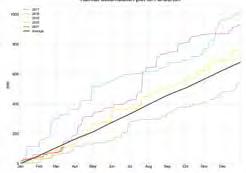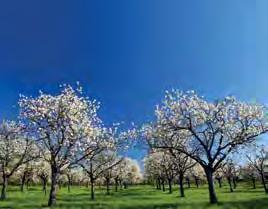
5 minute read
Still rather dry in the eastern South Island
By Georgina Griffiths : Meteorologist, MetService
At the time of writing (mid-March), the eastern South Island (Marlborough through to south Canterbury) year-to-date rainfall accumulations were running below normal. Figure 2 show year-to-date rainfall accumulation at Blenheim, Culverden, Christchurch and Ashburton, comparing the 2021 tally with the average year-to-date rainfall accumulation, as well as comparing to the last five years. All four locations continue drier than normal so far in 2021, with the dryness being most marked in Marlborough and north Canterbury, but less unusual for Christchurch and Ashburton.
Non-linear response to El Niño Southern Oscillation (ENSO)
Research in the early 1990s by one of our most highly respected climate researchers, Dr Brett Mullan, investigated the effects of both La Niña and El Niño events on seasonal rainfall across New Zealand. He identified a ‘non-linear’ response on rainfall in some regions of the country. Put simply, that means that the typical effects of La Niña are NOT equal and opposite to the normal outcomes during El Niño phases, for some regions of New Zealand. Canterbury and Otago are the standouts – often experiencing dryness or drought under persistent westerly regimes during El Niño events, AND drier than normal conditions while persistent Highs sit over the South Island during La Niña phases. Marlborough is a little less clear-cut, but La Niña summers can often by drier than usual, due to the influence of frequent Highs over the South Island.
Some years are drier than others – because of other climate drivers
Together, El Niño and La Niña are known as El NiñoSouthern Oscillation (or ENSO). The ENSO pattern exerts an important influence on New Zealand’s climate during its stronger phases. However, overall, ENSO only accounts for around 25% of the year-to-year variance in seasonal rainfall and temperature at most locations. Other factors, such as the Southern Ocean storminess, and what the Tasman Sea is getting up to, are also very important. Here at MetService, we routinely monitor a number of climate drivers that influence the New Zealand weather maps over the coming weeks and months. One of the reasons that the South Island has been ‘relatively’ quiet this summer is a relative lack of vigorous Southern Ocean weather systems (Figure 1).
Figure 1: The Southern Annular Mode (Southern Ocean storminess)
4
3
2
1
0
-1
-2
-3
-4 06 2019 07 2019 08 2019 09 2019 10 2019 11 2019 12 2019 01 2020 02 2020 03 2020 04 2020 05 2020 06 2020 07 2020 08 2020 09 2020 10 2020 11 2020 12 2020 01 2021 02 2021 03 2021 Figure 1: A plot of observed Southern Annular Mode (SAM, also known as Southern Ocean storminess) from 1 June 2019 to 16 March 2021, with forecast SAM values shown for the period 16–29 March 2021. Note the persistence of the positive phase since October 2020. The positive phase of the Southern Annular Mode implies a ‘quiet’ Southern Ocean in the New Zealand region. In other words, a lack of Southern Ocean storms washing up and over the country. The day-today weather maps often show High pressure near the Chatham Islands or lying across the South Island.
Figure 2: Rainfall accumulation
Annual rainfall accumulations (mm) for the following areas for the last five years. The annual average rainfall accumulation is shown in black.
Blenheim Culverden

Christchurch


Looking ahead
The waning La Niña should be gone for winter 2021. Under neutral ENSO conditions, the state of both the Tasman Sea weather systems and the Southern Ocean storms, will drive our winter weather patterns. As always, you should keep up to date with the MetService long-range forecast at http://metservice.com/rural/monthlyoutlook.
Or sign up to the Monthly Outlook for delivery straight to your email inbox at www.metservice.com/emails.
Ashburton


Sizing up copper – microscopic particles go far
Whether you are using copper to protect kiwifruit, avocados, citrus, fresh vegetables or summerfruit trees from bacterial disease in the weeks ahead, the key to success comes down to foliar coverage.
Copper fungicides work by preventing spore germination and can act at several other stages in the fungus development.
Without complete coverage plants can still succumb, as any untreated surface remains a potential disease infection site.
“Coverage is just as important as the quantity of actual copper on the plant surface,” says Alan Cliffe, research and development manager for Nufarm, the company which developed Tri-Base Blue®.
“That’s why particle size becomes such a priority, along with the type of copper complex used and product solubility.”
The tiny particles of Tri-Base Blue give excellent coverage and provide a greater surface area for the release of cupric (Cu++) ions than other products with larger particles.
Small particles adhere better and resist dislodgement better than larger particles, allowing the copper to act to its full potential against fungi and bacteria, Alan says.
The form of copper used in Tri-Base Blue, tribasic copper sulphate, gives a uniform steady release of Cu++ ions, provides very good weathering qualities and a low risk of phytotoxicity. Labelled crops include avocados (anthracnose), citrus (melanose, brown rot), grapes (downy mildew), kiwifruit (leaf spot, Psa), onions (downy mildew, bacterial blight), peas (downy mildew, ascochyta blight, bacterial blight), potatoes (early blight, late blight) and stonefruit (leaf curl, shot hole, bladder plum, bacterial blast).
Common uses at this time of the season include postharvest protectant sprays for summerfruit (apricots and cherries, for example, are particularly predisposed to bacterial blast at leaf fall); and autumn sprays to help prevent brown rot in citrus.
Following full registration for Psa last season, Alan says TriBase Blue is now becoming popular with kiwifruit growers as a liquid alternative to traditional granule and wettable powder copper formulations, and now is a good time to be planning ahead for post-harvest protectant treatments.
The stable, solvent-free formulation is easy to pour, mix into solution, handle and apply.
Tri-Base Blue disperses rapidly when added to the spray tank, can be applied in concentrate or dilute spray volumes, and is compatible with a wide range of other products, including most commonly used fungicides and insecticides. It has nil WHP (withholding periods) on all crops.
For more detail, talk to your horticultural representative today. Tri-Base Blue® is a registered trademark of Nufarm Australia Ltd.
Article supplied by Nufarm.










